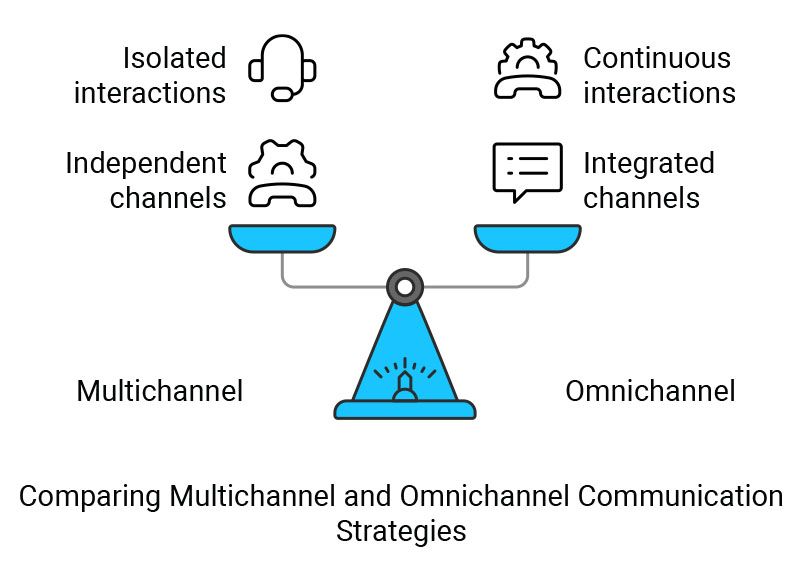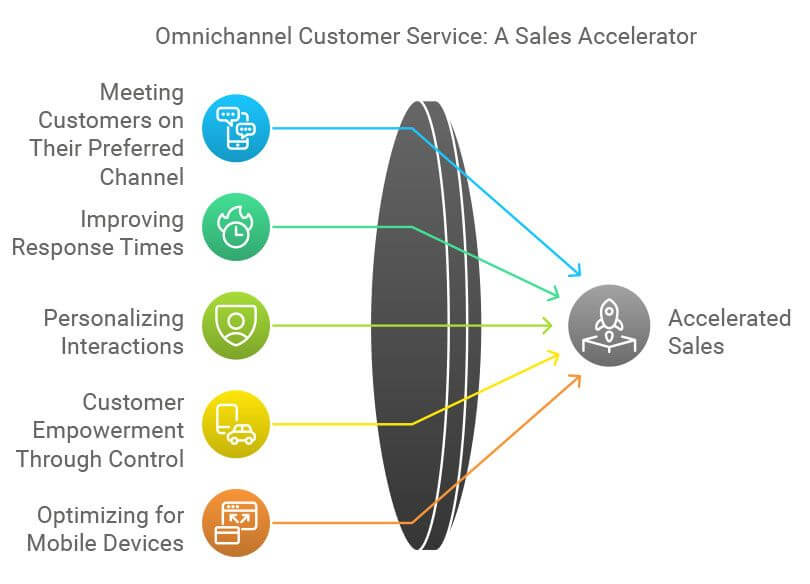
Table of contents
In today’s business environment, customer service has evolved from a simple problem-solving channel to a decisive factor for corporate success.
Modern consumers demand top-quality products and services and personalized, seamless, memorable shopping experiences.
Implementing an Omnichannel customer service strategy is essential to accelerate sales and stand out in a highly competitive marketplace.
With rapid technological advances and rising consumer expectations, customer service has become unprecedentedly relevant. It is no longer just about addressing complaints or resolving inconveniences but about establishing meaningful connections and delivering exceptional experiences with every interaction.
This new perspective enables companies to create lasting customer relationships, fostering loyalty and sustainable growth.
What is Omnichannel Customer Service?
Omnichannel customer service is a strategy that integrates all communication channels available to the customer into a unified and consistent experience. This includes digital channels such as email, social media, live chat, mobile apps, and text messaging, as well as traditional interactions such as phone calls and in-person customer service.
The key to the omnichannel approach is that all these channels are interconnected. Information flows between them, allowing customers to start an interaction in one channel and continue it in another without losing continuity or context.
This ensures that the customer does not have to repeat information and that customer service agents have a complete view of previous interactions.
Difference between Omnichannel and Multichannel
It is essential to distinguish between an omnichannel and a multichannel strategy:
- Multichannel: Companies offer multiple communication channels, but these operate independently. There is no integration or exchange of information between them. For example, a customer may contact the company by email or telephone, but each interaction is isolated.
- Omnichannel: All channels are integrated and work cohesively. The customer can start a conversation on social media, continue it via live chat, and finish it over the phone, with the agent having access to the entire history of interaction.
Adopting an omnichannel strategy means putting the customer at the center and designing processes that facilitate their experience across all touch points.
The Importance of an Omnichannel Approach for Business Owners
For entrepreneurs, implementing omnichannel customer service is a competitive advantage and a necessity in today’s marketplace. Customers expect fast, personalized, and frictionless interactions. Poor service can lead to lost sales and damage brand reputation.
According to studies, 53% of customers avoid doing business with brands they don’t trust, and an inconsistent or fragmented experience can erode that trust. On the other hand, 74% of consumers say a good experience is vital in influencing their loyalty to a brand.
By offering omnichannel service:
- You improve customer satisfaction by making their lives easier and solving their problems efficiently.
- You foster loyalty by creating positive and memorable experiences.
- You increase sales by taking advantage of multichannel opportunities and providing personalized attention.
Benefits of Omnichannel Customer Service to Accelerate Sales
Meeting Customers in their Preferred Channel
Customers have different preferences for communicating with companies. Some prefer social media, while others prefer email, live chat, or even traditional phone calls. You increase the chances of interaction and conversion by being present in multiple channels and allowing the customer to choose the one that suits them best.
Example: A fashion company detects that its young audience prefers to interact through Instagram and WhatsApp. Focusing on these channels increases the options of achieving higher engagement and increased sales among this segment.
Improved Response Times
In a world where immediacy is critical, customers expect quick responses. An omnichannel approach enables:
- Immediate access to customer information: Agents can view the entire history of interactions, which speeds up query resolution.
- Response automation: Through chatbots and pre-determined responses for frequent queries.
- Reduced wait times: Distribute the load among different channels using intelligent routing tools.
Fact: Studies show that 53% of US online customers will abandon a purchase if they do not get a quick answer to their questions.
Personalizing Interactions
By integrating data from all channels, you can get a 360° view of each customer:
- Purchase history
- Preferences and behaviors
- Previous interactions and feedback
This allows you to offer personalized recommendations, special promotions, and a treatment that makes the customer feel valued and understood.
Example: An online store uses a customer’s browsing and purchase history to send them personalized email offers and mobile app notifications, increasing the likelihood of a sale.
Customer Empowerment Through Control
Customers appreciate having control over how and when they interact with a company. By offering self-service options:
- Dependency on support agents is reduced.
- Customers can solve simple problems independently, such as tracking orders or updating personal information.
- Satisfaction is improved by providing immediate solutions.
Optimization for Mobile Devices
With the increased use of smartphones, all interactions must be optimized for mobile devices. This includes:
- Responsive websites.
- Intuitive mobile applications.
- Communication via SMS and messaging applications.
Efficient mobile service facilitates shopping anytime and anywhere, increasing sales opportunities.
Example: A delivery company implements push notifications on its mobile app to inform customers about the status of their orders in real time, improving the experience and reducing customer service queries.
How to Implement an Omnichannel Customer Service Strategy
Implementing an omnichannel customer service strategy is critical to meeting modern consumer expectations and staying competitive in today’s marketplace. This process involves integrating all communication channels to deliver a consistent and personalized experience at every customer touchpoint.
Understand your customers’ expectations and needs
- Conduct surveys and market research to understand your customers’ preferences.
- Analyze existing data to identify behavioral patterns.
- Create customer profiles (buyer personas) to segment and personalize strategies.
Use analytics tools such as Google Analytics, HubSpot, Zoho CRM, or the analytics capabilities built into your VoIP platform to track interactions across all channels and gain valuable insights. These tools will allow you to identify behavioral patterns, measure the effectiveness of your strategies, and make informed decisions to improve the customer experience.
Expert Tip
Identify and Select Key Channels
You don’t need to be on every channel, just those relevant to your target audience. Consider:
- Popular social networks among your audience (Facebook, Instagram, LinkedIn, etc.).
- Messaging apps (WhatsApp, Messenger).
- Traditional channels (phone, email).
- Advanced VoIP phone service.
Example: If your target market is B2B professionals, LinkedIn can be a more effective channel than Instagram.
Invest in the Right Technology
Technology is the enabler of a successful omnichannel strategy. Some essential tools include:
- It has integrated CRM systems that collect and manage customer data.
- Contact center software that unifies communication channels.
- Marketing automation platforms to send personalized messages.
- Artificial intelligence solutions such as chatbots and predictive analytics.
- VoIP (Voice over Internet Protocol) solutions: this technology allows you to integrate voice communications into your digital platform, facilitating phone calls over the Internet. This reduces the costs associated with traditional telephony and offers greater flexibility and scalability.
Fact: Companies using omnichannel technology report a 91% increase in customer retention rate.
Train your Customer Service Team
The human factor is essential. Make sure your team:
- Have a thorough understanding of products and services to provide accurate information.
- Be familiar with all channels and tools used.
- Develop soft skills such as empathy, effective communication, and conflict resolution.
Implement ongoing training programs and establish clear service protocols..
Expert Tip
Implement Self-Service Options
Make it easy for customers to find answers for themselves:
- Updated FAQ sections.
- Tutorials and guides in text and video format.
- Online forums and communities where customers can help others.
- Intelligent chatbots that solve common queries.
Benefit: This reduces the support team’s workload and improves customer satisfaction.
Ensures Data Security and Privacy
With the increase in interactions and data collected, it is critical to protect customer information:
- Comply with GDPR (General Data Protection Regulation) and other local laws.
- Implement robust security protocols, such as encryption and multi-factor authentication.
- Communicate security measures to your customers to build trust.
Plan the Complete Customer Journey
- Map all touchpoints, from awareness to post-sales.
- Identify potential obstacles or frictions in the journey.
- Optimize each stage to deliver an exceptional experience.
Example: An online store identifies that many customers abandon the cart during checkout. Simplifying this step and offering real-time support reduces abandonment and increases conversions.
Best Practices for Successful Omnichannel Customer Service
These best practices will enable you to deliver a consistent, high-quality customer experience across all channels, strengthening loyalty and increasing sales.
- Consistency in Brand Voice and Message: Ensure communication maintains the same tone and values across all channels.
- Continuous Monitoring and Analysis: This process uses KPIs and metrics to evaluate performance, such as Net Promoter Score (NPS), first contact resolution rate, and average response time.
- Customer Feedback: Solicits and values customer feedback to identify areas for improvement.
- Intelligent Automation: Implements automations that improve efficiency without sacrificing personalization.
- Adaptability and Constant Updating: Keep up with technology trends and changes in customer behavior.
Omnichannel Customer Service Challenges and How to Overcome Them
Overcoming challenges such as technological complexity and the need for an aligned organizational culture is vital to the success of your omnichannel strategy.
Below, we will discuss the main obstacles companies face when implementing this approach and offer solutions to overcome them, allowing you to fully take advantage of this innovative strategy’s benefits.
- Systems and Channel Integration
- Challenge: Integrating multiple platforms and channels can be complex.
- Solution: Select technology solutions that enable integrations and use open APIs. Consider working with vendors that offer all-in-one platforms.
- Organizational Change Management
- Challenge: Implementing an omnichannel strategy requires changes in processes and mindset.
- Solution: Communicate the benefits to the entire team, engage leaders in each area, and offer training to ease the transition.
- Data Protection and Compliance
- Challenge: Handling large volumes of data increases the risk of non-compliance and security breaches.
- Solution: Implement strict security policies, train staff on best practices, and stay current with regulations.
- Customer Experience Consistency
- Challenge: Maintain a uniform experience across all channels.
- Solution: Establish service standards and protocols, use monitoring tools, and perform regular audits.
What is VoIP, and how can VoIPstudio boost your omnichannel strategy?
To improve customer service, efficient and flexible communication tools are essential. VoIP (Voice over Internet Protocol) is a technology that allows voice and video calls over the Internet, replacing traditional phone lines and offering greater flexibility and cost reduction.
VoIPstudio is a cloud-based business telephony solution that leverages VoIP technology to deliver multiple benefits to your omnichannel strategy:
- Multichannel Integration.
- Voice calls, messages, and video conferencing: This all-in-one platform facilitates internal and external communication.
- Integrations with CRM and other tools: Access customer information in real-time during interactions, improving personalization and efficiency.
- Advanced Call Center Features
- Intelligent call routing: Directs calls to the most appropriate agent according to defined criteria, optimizing customer service.
- Interactive Voice Response (IVR): Automates initial attention and guides customers efficiently.
- Mobility and Flexibility
- Access from any device: Computers, smartphones, and tablets, allowing your team to work from anywhere.
- 24/7 Support: Maintain availability and always respond to your customers’ needs.
- Security and Compliance
- Data encryption: Protect communications and sensitive information.
- Compliance: VoIPstudio complies with international VoIP security and privacy standards.
- Detailed Analysis and Reporting
- Real-time metrics: Monitor your team’s performance and customer satisfaction.
- Customized reports: Get insights to make informed decisions and continuously improve.
- Support and Advice
- Expert Team: Assistance in implementing and optimizing solutions.
- Constant updates: Access to the latest features and enhancements.
Try VoIP Telephony for free with VoIPstudio.
Implementing VoIPstudio in your business allows you to:
- Improve operational efficiency: By centralizing communications and automating processes.
- Increase customer satisfaction By offering fast, personalized attention on multiple channels.
- Reduce costs: By leveraging cloud technology and eliminating costly infrastructure.

Questions about Omnichannel Customer Service
What is omnichannel customer service?
Omnichannel customer service is a strategy that integrates all available communication channels to provide the customer with a unified and consistent experience. This means that whether the customer contacts the company by phone, email, live chat, social media, or in person, all interactions are connected. The customer can switch from one channel to another without losing continuity, and the company has access to the entire communications history, facilitating more personalized and efficient service.
What is an omnichannel service?
An omnichannel service provides customers with an integrated and consistent experience across all communication channels and touchpoints. This includes digital media such as websites, mobile apps, and social media, as well as traditional channels such as physical stores and call centers. The goal is that the customer can interact with the company seamlessly, no matter their chosen channel, and that information and context are maintained across all interactions.
What is omnichannel?
“omnichannel” refers to a customer-centric business strategy that seeks to deliver a cohesive, seamless experience across all channels and touchpoints. This implies that all channels (online and offline) are interconnected and synchronized, allowing the customer to move between them without losing information or inconsistencies in communication or service.
What does omnichannel experience mean?
The omnichannel experience is the perception that the customer has when interacting with a company that has implemented an omnichannel strategy. It means that the customer enjoys a seamless and consistent interaction across all channels, where their preferences and the history of their interactions are recognized and used to deliver a personalized service. This experience eliminates barriers between channels and provides a closer and more efficient relationship between the customer and the company.
More from the blog
Want to improve your business communication?
Unlock enterprise-class call center power at affordable prices – no hardware, no delays, no surprises!








